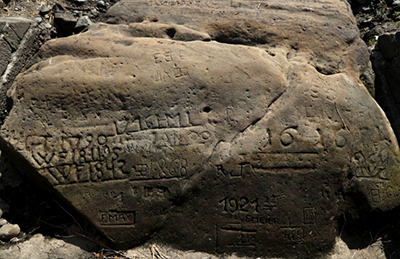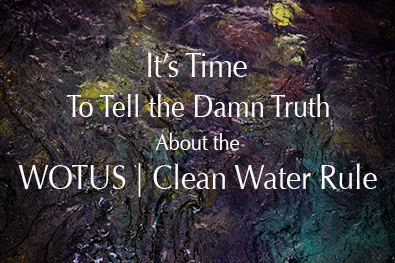Trigger Warning: Another lengthy post follows that loosely deals with politics, and I’ve gored a couple of popular sacred oxen here; if you’ve had a belly full this week, don’t read this one. As always, comments are most welcome if you’ve got something that genuinely adds to the conversation.
Hunger Stones, Hot Air (Literal and Figurative), and Cycles
Heard about the Elbe River hunger stones (Czech Republic) showing up again lately? If you’re a mainstream news reader, probably not.
 Somewhat ironically, and then again perhaps it’s not, one of the most thorough postings we’ve read about hunger stones in the past few days was written by an astute macroeconomist, Martin Armstrong. His post The Hunger Stones Have Appeared is quite interesting, at least if you have a genuine, open-minded interest in climate science, which is in part based upon understanding climate history. (Image from linked article.)
Somewhat ironically, and then again perhaps it’s not, one of the most thorough postings we’ve read about hunger stones in the past few days was written by an astute macroeconomist, Martin Armstrong. His post The Hunger Stones Have Appeared is quite interesting, at least if you have a genuine, open-minded interest in climate science, which is in part based upon understanding climate history. (Image from linked article.)
From his article –
While the Global Warming fanatics are out in force saying “see” the heat in Europe is caused by humans driving their cars around, they continue to ignore history. The extreme heat in Europe this year is part of a cycle. The swings from extreme heat to extreme cold are also not unheard of. Another piece of historical evidence they ignore is known as the Hunger Stones. Pictured here is a Hunger Stone from 1616 which has been exposed by the low level of water in the Elbe River. This is at Decin, in the Czech Republic. Throughout the centuries, there have been these cycles of extreme heat followed by extreme cold. Such events have been recorded when drought has resulted in the low level of water in the Elbe river.
This year’s drought in Europe has exposed once again the Hunger Stones that have been used for centuries to commemorate historic droughts which warn of their consequences when you see these stones again. The Hunger Stones are visible in the Elbe River once more. This is a major river which begins in the Czech Republic and flows through Germany. There are more than a dozen Hunger Stones that serve as records of previous droughts establishing that the extreme heat and drought of this year is by no means unique to history.
The various Hunger Stones record droughts that resulted in famine and soaring prices for food. The droughts that have been recorded on the stones date to 1417, 1616, 1707, 1746, 1790, 1800, 1811, 1830, 1842, 1868, 1892, and 1893, which covers a period of 476 years…
He goes on to analyze the periodicity of the drought events (the cycles), and weaves in a fascinating bit of vulcanology (current and historical), solar observation, and astronomy via meteors. (Worth your time.)
His points: 1) current climatic events, viewed through the lens of what appears to be fairly well documented history, do not appear to be unique to our current time, nor do they appear predominantly attributable to the climatological villains of the day (belching and farting cows and pigs, big oil, coal mines in Kentucky and Montana, fill in your favorite villain here, etc.). And 2) ignore history at your own peril.
Minor corollary #1 (thrown in for absolutely free): A wise mentor recently reminded that we should beware those who urge upheaval and ignore, suppress, or outright deny history.
The Green Wave, and the Fly in the Proverbial Ointment
Among our fly fishing and outdoor brethren and sistren there continue to pop up here and again articles urging we citizens of planet earth to resist evil political forces, at least voting our environmental conscience(s), or outright chasing the evil bastards (label your favorite targets accordingly) from the halls of power with pitchforks and axe handles in hand.
[We’re all for folks voting for the issues they’re most passionate about, and we’re (as proven by a 10 year track record here on ChiWulff) damned passionate about public lands, clean water, and the pursuit of happiness therein – among many other issues.]
For example, see The Coming Green Wave (New York Times) or this poll on voting preferences recently conducted on Angling Trade. To be fair, considering the population, AT’s population sample size ends up being a wee bit small to suggest there’s a lot of momentum (1.658E-5%), but hell, the poll feels good, and what could possibly be faulty about voting your fishing conscience, right?
For the record, I’m all in for a green wave, coupled with a demonstration of any sort of fiscal responsibility in Washington. (I know, that pairing is dreaming the impossible dream…)
Interestingly, the Gallup organization, with roots in polling dating back to 1948, has been tracking a little survey they title the Most Important Problem tracker, with monthly updates provided (apparently since 1956 given the lower graph on the link page).
From the August 2018 survey, the top concerns of voters in the country were listed as follows (just the top ten here):
21% – Dissatisfaction with Government
16% – Immigration/Illegal Aliens
7% – Race Relations/Racism
6% – Unifying the Country
5% – Lack of respect for each other
5% – Healthcare
5% – Economy in general
4% – Unemployment/Jobs
4% – Ethics/morals/religious/family decline
3% – Poverty/Hunger/Homelessness
The next nine issues listed tied at 2% – the gap between rich and poor, taxes, eduction, guns/gun control, international issues, the media, crime and violence, and drugs, and the environment/pollution.
The point: there are a lot of very legitimate “interest” irons in the political fire this election season; encouraging / cajoling / shaming folks to vote a single issue – their environmental conscience in this case – is all well and good, but likely, given Gallup’s data, a strategy destined to motivate precious few in the big picture, as life simply isn’t a single issue game (and probably wasn’t ever intended to be).
So What’s the Environmentally-Minded, Thoughtful Sportsman Sportsperson to Do?
I recently had the good fortune to spend a couple of hours on a conference call with several good friends, to the person all active fishers, hunters, and lovers of public lands discussing this very question (among many others). We agreed on several suggestions as follows…
Don’t forget to embrace the fall outdoor season. Most of us on the call that day agreed that the fall season, particularly in the Northern Rockies, is the most glorious window in the year to be on the rivers or creeks (fall hatches can be stupendous) and chasing whatever critters (four-legged or winged) be your interest for the fall hunts. A dawn to dusk fall day outside is a powerful antidote to the 24/7 political snipe fest ongoing in the news.
Dig deeper when your favorite legacy advocacy group tells you to do something. As an example, see this little post on the WOTUS, or consider this whopper of a logical fallacy recently presented by TU’s Chris Wood in the Denver Post. Need a simple primer on logical fallacy? Read this. (More on the Chris Wood piece to come; there’s a much deeper layer to that story than he shared.)
Keep an eye out for new advocacy groups that want to get things done on the ground and not in Washington. For example, we’ve mentioned it before, the group that will launch in 2019 as an alternative to TU is rolling along nicely. All resources to be dedicated to actual projects, not fundraising and maintaining offices and lobbying efforts in Washington; should be interesting.
Dig deeper when you’re told a science story, particularly when it’s presented as an unchallengeable, incontrovertible truth. I recently wrote when talking about the WOTUS a few months back –
All three organizations called out here have at some point recently implored that “good or sound science” be used when making management land and water management decisions that affect us all.
As a scientist with post-doctoral training I couldn’t agree more, though it’s fair to point out that one should be damned careful what you wish for. Science has never been, and never will be, a consensus sport – it is a challenge, prove, re-prove, challenge again, prove again, etc. sport. Digging into the nitty gritty in the science world can be a forbidding intellectual chore and just damned hard, grind it out work, isn’t very sexy, and doesn’t often yield engaging Instagram posts. Cherry-picking studies and relying on media outlets, various pundits, and social media to interpret science for you will eventually bite you in the ass.
Speaking of science, responsible outdoor folks, whether you consider yourself an ‘environmentalist’ or not, have to push for rational discussions on energy. This is simply a math issue. There is a fairly easily quantifiable level of national (and world) energy demand that must be met within sustainable cost and pollution targets. For example, anyone who looks at the math and insists on globally killing coal without taking a serious look at another energy-dense replacement, for example nuclear (thorium my friends) isn’t truly interested in solving the challenge. Renewables are nifty, yet pretty damned expensive and don’t offer anywhere near the energy density to cost ratio that other fuels offer, and therefore won’t solve the global pollution issues (ie China and India) that are thrown out before us daily.
Public lands are vital and essential; always have been, always will be. That said, western states that are majority federal and state-held land (thinking of the poster children Nevada, Utah, Alaska, and Idaho) deserve an honest hearing about locally-responsive management of lands within their borders. Not an easy nut to crack, but this one isn’t going away, and again it’s a math issue.
State budgets, crushed by Medicaid expansion (thanks to Obama-Care and years of Congressional inaction/nose-picking) and legacy pension costs, will be the biggest public land threats to come. I’m rounding up the math / data to back this up, and will share it soon; it’s quite easy to find, and all in the public record.
This won’t be a popular topic, but it’s a reality staring us in the face, and we’d be wise to get out ahead of it. It won’t be easy, and can’t be solved by just endlessly raising taxes. By the way, it’s a stunningly bipartisan failure that led us to this point.
Stay sane this fall my friends.
Cheers.

